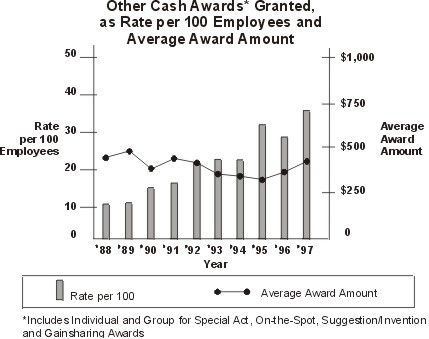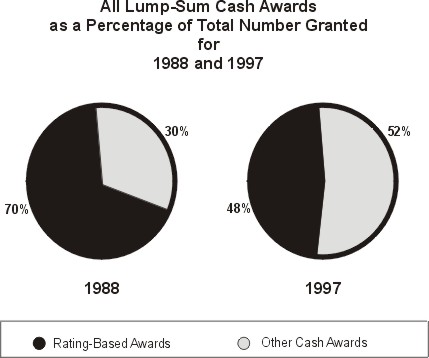You have reached a collection of archived material.
The content available is no longer being updated and as a result you may encounter hyperlinks which no longer function. You should also bear in mind that this content may contain text and references which are no longer applicable as a result of changes in law, regulation and/or administration.
Trends and Shifts in the Use of Awards Governmentwide
Trends and Shifts in the Use of Awards Governmentwide
The Office of Personnel Management (OPM) tracks awards granted to Federal employees of Executive Branch agencies. Our awards data show trends, shifts, and consistencies in how agencies have used awards in the past. This article reports on the use of cash awards from 1988 through 1997 and highlights significant findings on--
Total Spending
In comparison to criticism of agencies' use of awards, our data show that agencies have been prudent in granting cash awards.

Awards spending consistently has remained at or below 1 percent of total salaries. At the same time that total spending has been consistent, the data show subtle changes in the type of awards agencies are granting. The chart above depicts the consistency of awards spending. It also shows a general trend of agencies to spend a decreasing percentage of their awards monies on rating-based awards and an increasing percentage on other cash awards.
Rating-Based Awards
Compared to Other Cash Awards. Rating-based awards are cash awards based on a rating of record earned through the performance appraisal process. The chart below shows that from 1988-90, larger rating-based awards were given to fewer people than in later years. Between 1991-95, the number of rating-based awards increased while the average award amount remained about the same, but the trend for 1996-97 appears to be reverting to larger rating-based awards granted to fewer people.

The chart below shows that the use of other cash awards has increased steadily while the average amount generally has remained constant, with a slight rise in the average amount in the last 3 years.

We attribute the decreased use of rating-based awards and the increased use of other cash awards to 1995 regulatory changes. Previously, the regulatory definition for special act or service awards required they be based on non-recurring contributions. When we lifted that limitation, it became possible to use special act or service awards to recognize recurring achievements.
Between 1988 and 1997, agencies moved from granting mostly rating-based awards to granting other types of lump-sum cash awards. In fact, 1997 was the first year in which the number of other cash awards granted exceeded the number of rating-based awards granted. We ascribe this trend not only to increased use of "on-the-spot" cash awards, which often can be processed more quickly than other kinds of awards, but also to adoption of two-level appraisal programs that rely on other cash awards rather than rating-based awards to recognize employees.

Caution
When reviewing this data, we urge readers to use it carefully. Each agency has designed its own awards program to support its specific mission. Governmentwide averages often mask the differences designed into agency programs (e.g., some agencies no longer grant rating-based awards while other agencies still use them as their primary tool of recognition). Governmentwide average award amounts or rates per 100 employees should not be used as benchmarks or goals to achieve. Because of the unique design of various awards programs, agencies should evaluate their programs as to whether the program achieves its goals and whether managers and employees are satisfied with it-not whether the program matches Governmentwide averages or rates.



